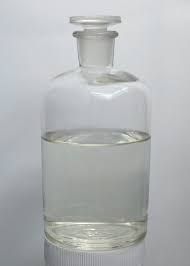The lusterless sunken eyes of Nitric-acid suggest also Sulphur. The cornea are similar to Calcarea-carbonica. The paralysis of the upper eyelids remind us of Phosphorus and Causticum. Drooping of the upper eyelid is Dr. Guernsey’s key-note of Causticum. His expression is: “Her eyelids are so heavy she cannot keep them up; they seem paralyzed, Causticum.”
The discharge of pus from the ears suggests pulsatilla and Carcarea-carbonica as well at Nitric-acid. The echo in the ears of one’s own speech suggests Causticum. The redness of the tip of the nose suggests Aloes, Carbo-vegetabilis, and Sulphur.
The following are additional comparisons.
Nose red in young women. Borax.
Nose of copper-red color. Cannabis-indica.
Tip of the nose red and knobby. Aurum-metallicum.
Itching of the tip of the nose. Silicea.
Eruption of pimples upon the tip of the nose. Causticum.
Crawling sensation in the tip of the nose. Moschus.
The child rubs the nose with the fist or on the shoulder of the nurse. Cina.
The child wakens at night and rubs the nose so much and so long that the parents are frightened. It won’t stop rubbing its nose. Lycopodium. (Guiding Symptoms.)
Nitric-acid has sneezing during sleep.
Nitric-acid has coryza, hoarseness, and sore-throat. The nose is stopped up, and yet it runs water. Head feels like a board, and the patient feels beaten and bruised all over.
Dr. Lippe spoke of the peculiar coryza of Nitric-acid. He said that Nitric-acid is almost certainly the remedy where we had the three symptoms together, coryza, hoarseness, and sore throat. That the running of water from the nose, which is at the same time stopped up, is characteristic of Nitric-acid.
Scurf in the nose is under Calcarea-carbonic as well as Nitric-acid. Sticta-pulmonaria has the characteristic, the secretions from the nose dry up so rapidly that they form crusts upon the entrances to the nostrils. Complete obstruction of the nose is characteristic of Nitric-acid, but also occurs under Lycopodium and Silicea.
Nitric-acid has mucus dropping through the posterior nares. This is the great characteristic of Kali-bichromicum.
The soreness of the throat in coryza, under Nitric-acid, is a stitching soreness.
Petroleum has fluent coryza and hoarseness.
Nitric-acid has bloated condition around the eyes on waking early. This is similar to Apis.
Nitric-acid has swelling of the lips. Calcarea-carbonica has swelling of the upper lip. Apis has the same symptom.
Nitric-acid is useful in painful swelling of the submaxillary glands. This is similar to Calcarea-carbonica.
Pain in hollow teeth, especially after the abuse of Mercury, indicates Nitric-acid.
Under Nitric-acid the gums are white, swollen, and bleeding. This is similar to Mercurius. Dryness of the mouth with thirst indicates Nitric-acid and Natrum-muriaticum.
Nitric-acid has ptyalism, like Mercury. Phosphorus has bloody ptyalism.
Sensitive tongue, with smarting sensation, even from mild food, indicates Nitric-acid and Natrum-muriaticum. A white dry tongue indicates Nitric-acid and Apis.
Violent thirst in the morning in those suffering from suppuration of the lungs, indicates Nitric-acid. This, according to Dr. Lippe, is a clinical observation of Hahnemann.
Perspiration during and after eating indicates Nitric-acid and Naturm-carbonicum.
The Nitric-acid patient gets water-brash from drinking fast.
Pain in the cardiac orifice of stomach on swallowing food indicates Nitric-acid. It also indicates Phosphorus, Alumina, and Bryonia.
When the Nitric-acid patient takes cold it generally settles in the abdomen and causes colic. This is characteristic of Nitric-acid.
Incarcerated flatulence in the upper abdomen indicate Nitric-acid. Aloes and Lycopodium also have it, but under Lycopodium it is worse at night.
Nitric-acid has stitches and pricking in the rectum, with tenesmus after stool.
Nitric-acid is indicated in children who are troubled with incontinence of urine, and so is Causticum.
Nitric-acid is particularly useful in inflammation of the prepuse with swelling and phymosis. Mercury and Sulphur are also indicated. In the Nitric-acid patient the testicles hang down too low.
Under Nitric-acid the menses are too early, like Calcarea. During menses there is colic, and this also indicates Natrum-carbonicum.
Nitric-acid has soreness of chest from deep breathing and coughing it. This is an excellent indication for calcarea.
The stitching pains in and between the shoulder-blades, the pain in the small of back from taking cold and the swelling of the glands of the neck and axilla, are indications for both Calcarea and Nitric-acid.
Nitric-acid has falling to sleep of the hands, especially in the morning in bed. Pain as from tension in right hip-joint. According to Dr. Malcolm Macfarlane, one of the great characteristics of Nitric-acid is soreness. There is soreness of the corners of the mouth; soreness of the inside of the nostrils; soreness of the shins. The shins are so sore the patient wishes to cover them with wet cloths.
Nitric-acid has a great characteristic of sticking pains or stitches, as if from needles or splinters. In this it is similar to Hepar. There are stitches in the heels when stepping; the patient feels as if stepping on needles.
Nitric-acid has offensive foot-sweat, and so also has Silicea. The Nitric-acid foot-sweat causes soreness between the toes.
Nitric-acid is the remedy for bunions with swelling and with stinging pains. Nitric-acid, said Dr. Lippe, is almost a specific for bunions.
Nitric-acid has sore pains of internal organs. Emaciation of the upper extremities is an indication for Nitric-acid. Nitric-acid is a great remedy for syphilis after the abuse of Mercury, It also follows Mercury, homoeopathically given, in syphilitic cases.
It is like Thuja, a great remedy for sycotic condylomata.
During sleep there is bleeding of the nose, and this is similar to Mercury. Coughing and sneezing during sleep is another indication for Nitric-acid.
Continuous chilliness is a symptom of Nitric-acid, and also reminds us of Pulsatilla.
Nitric-acid has perspiration at night on the side on which he lies, whilst Silicea has perspiration on the side on which he does not lie. Symptoms like this are liable to be overlooked, yet if kept well in mind are invaluable in selecting the remedy. Chill, heat, and sweat following one another suggest China and Pulsatilla as well as Nitric-acid.
Nitric-acid and Apis have nettle rash, with burning, stinging pains.
Nitric-acid has large blood boils like Arnica. The great characteristic of Nitric-acid in boils is the pain like splinters.
Painless swelling of the glands is the indication for Silicea. Nitric-acid has swelling of the glands with pain as if from splinters.
Hahnemann’s keynote for Nitric-acid is that the drug is suitable after alkalies for lean persons with dark complexion, black hair and eyes.
Nitric-acid has aggravation after breakfast, in warm air, after lying down, after perspiration, and in the erect posture. Sulphur also has aggravation in the erect position. In fact, in some conditions the Sulphur patient is totally unable to stand erect, but must bend over.
Nitric-acid has amelioration from drawing clothing tight around the waist. This is the reverse of a number of remedies.
Dr. Guernsey’s keynotes for Nitric-acid are as follows:
Leucorrhoea of mucus, which can be drawn out. It may be flesh-colored, greenish, cherry red, and fetid. Violent pressing downward, as if everything were coming out of the vulva, with pain in the small of the back, through the hips and down the thighs. Very painful stools with profuse discharge of blood, the pain lasting a long time and exhausting her. The urine is very strong, like horse urine. Sleeps badly the latter part of the night. Suitable for cases that are suffering from mercurial poisoning. Stitches in the vagina from without inwards when walking in the open air. Tumors, with much itching and stitching pains. Itching of the parts when walking, or otherwise irritating them, when they feel very sore. Pricking pains prevail. Violent itching of the vulva, always toward evening.
Swelling and burning itching of one side of the vulva and vagina. Dry-burning heat of the vulva. The urine is very offensive. Patient always worse after twelve o’clock at night. Violent cramp-like pains, as if the abdomen would burst with constant eructation’s. Hard knots in the mammary glands of mercurialized women. Constant eructation’s during the menses. Menses too early and too profuse. Metrorrhagia after confinement or miscarriage. Much nausea and gastric trouble, relieved by moving about or riding in a carriage. Constant nausea, with heat in the stomach extending to the throat. Fat food causes nausea and acidity. Hard, difficult, scanty stool. On going to stool pain in rectum, as if something were being torn away, or else twitching’s in the rectum and spasmodic contractions of anus for many hours afterward. Smarting more in the rectum than in the anus immediately after stool and continuing many hours afterward. Sometimes prolapse of rectum and discharge of blood. Pain before and after stool as from a fissure or anus.
Much swelling of the internal ear. It is nearly closed. There is much pain in it. Much restlessness after midnight.





